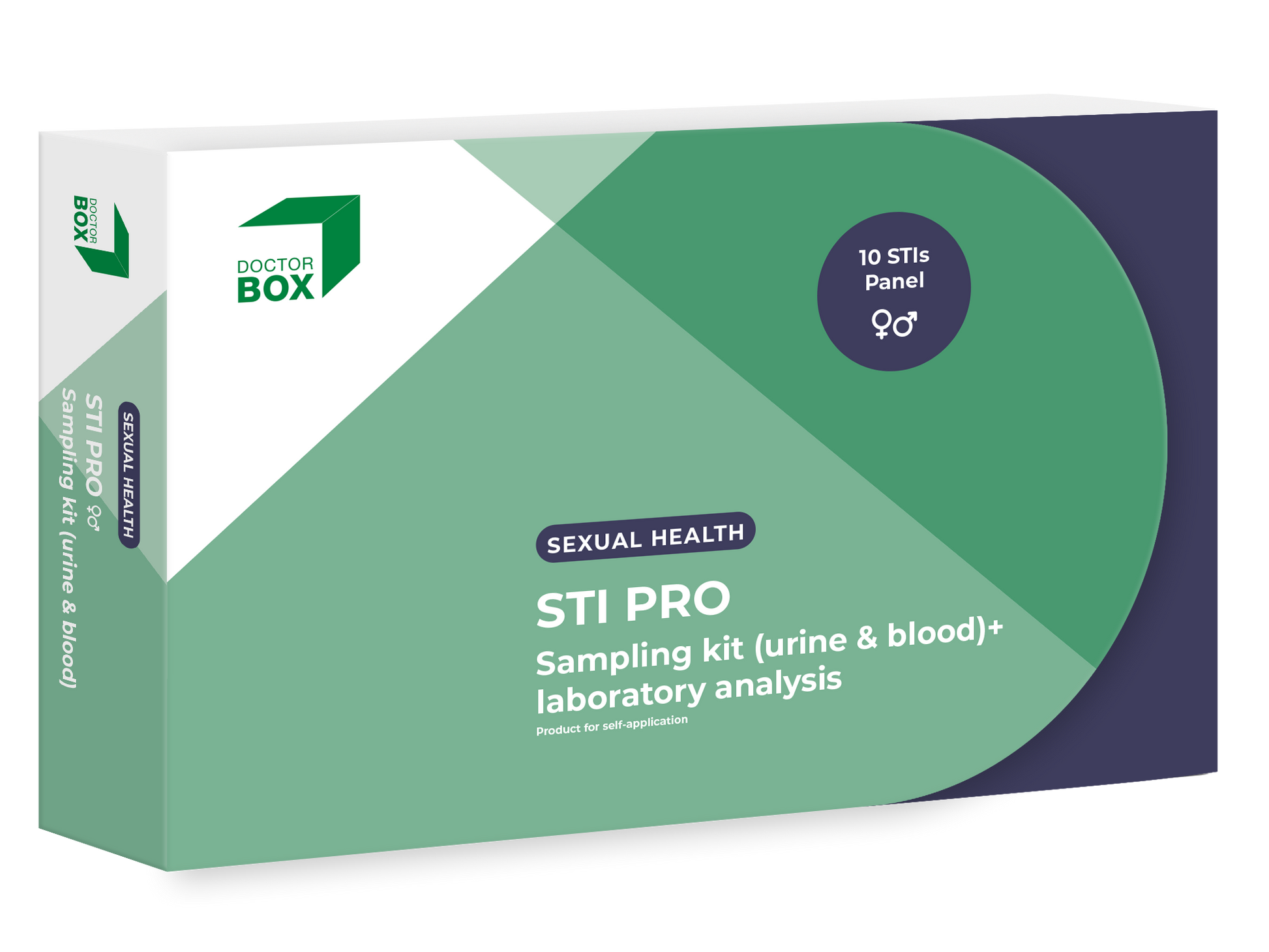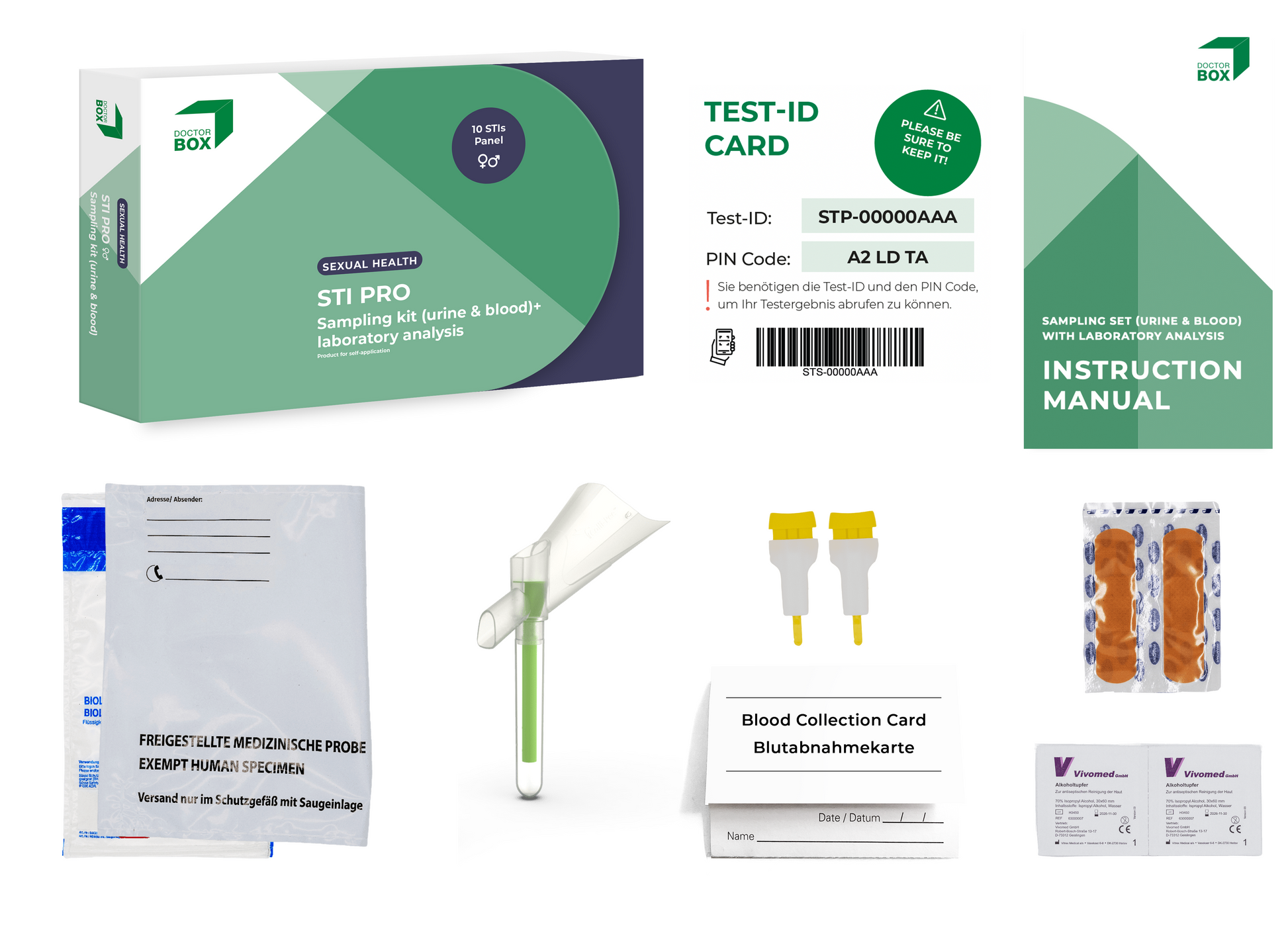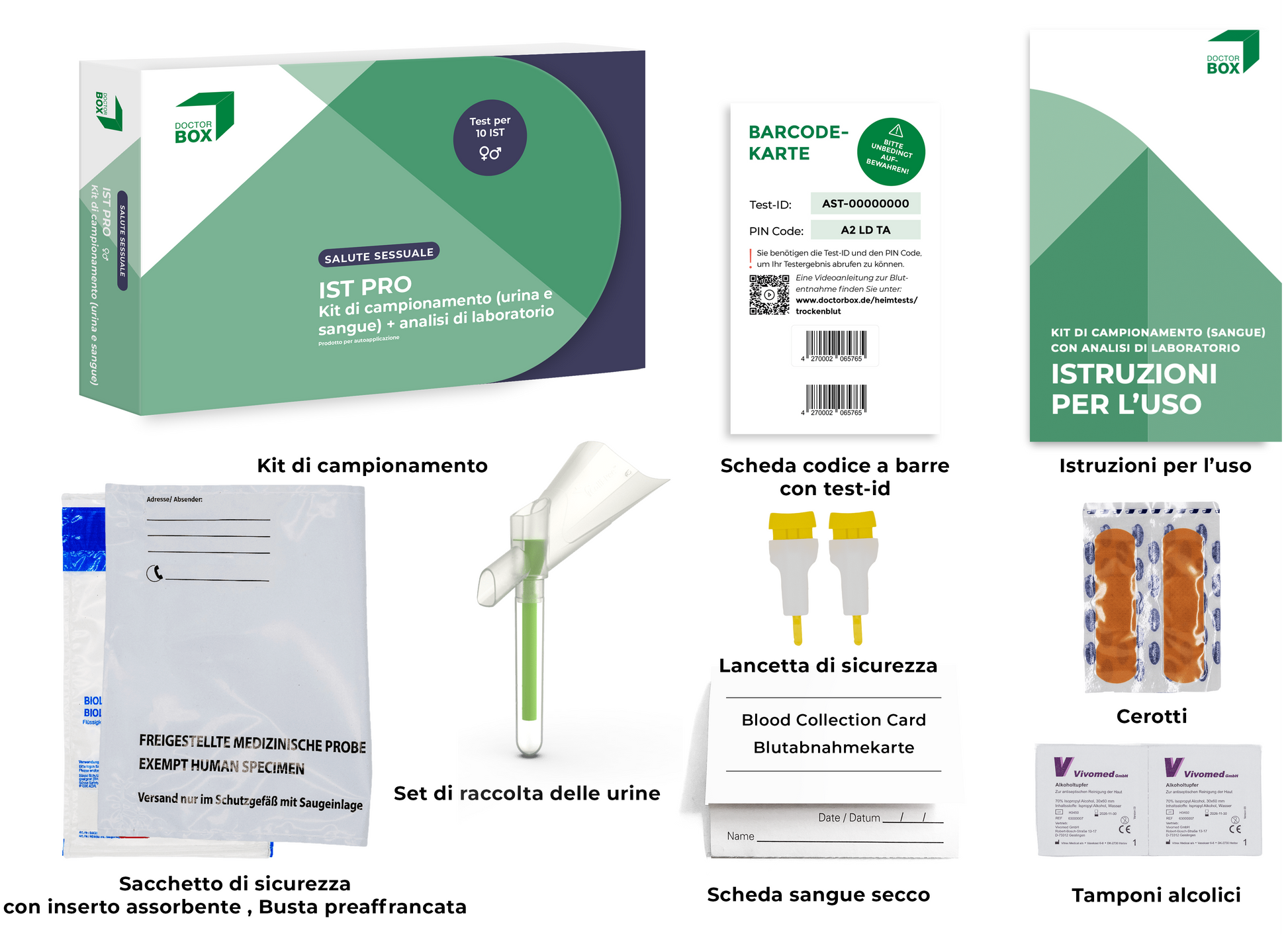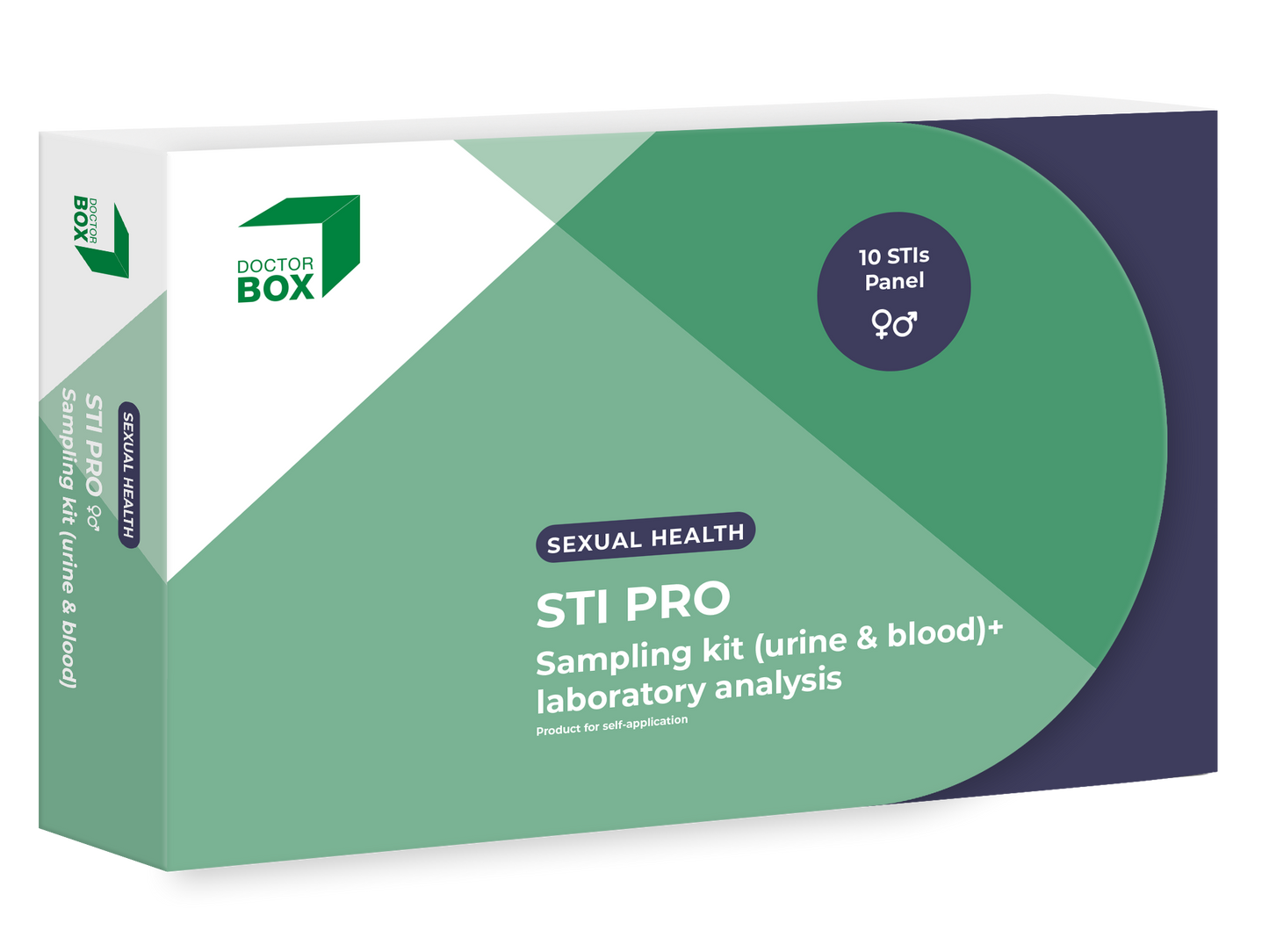
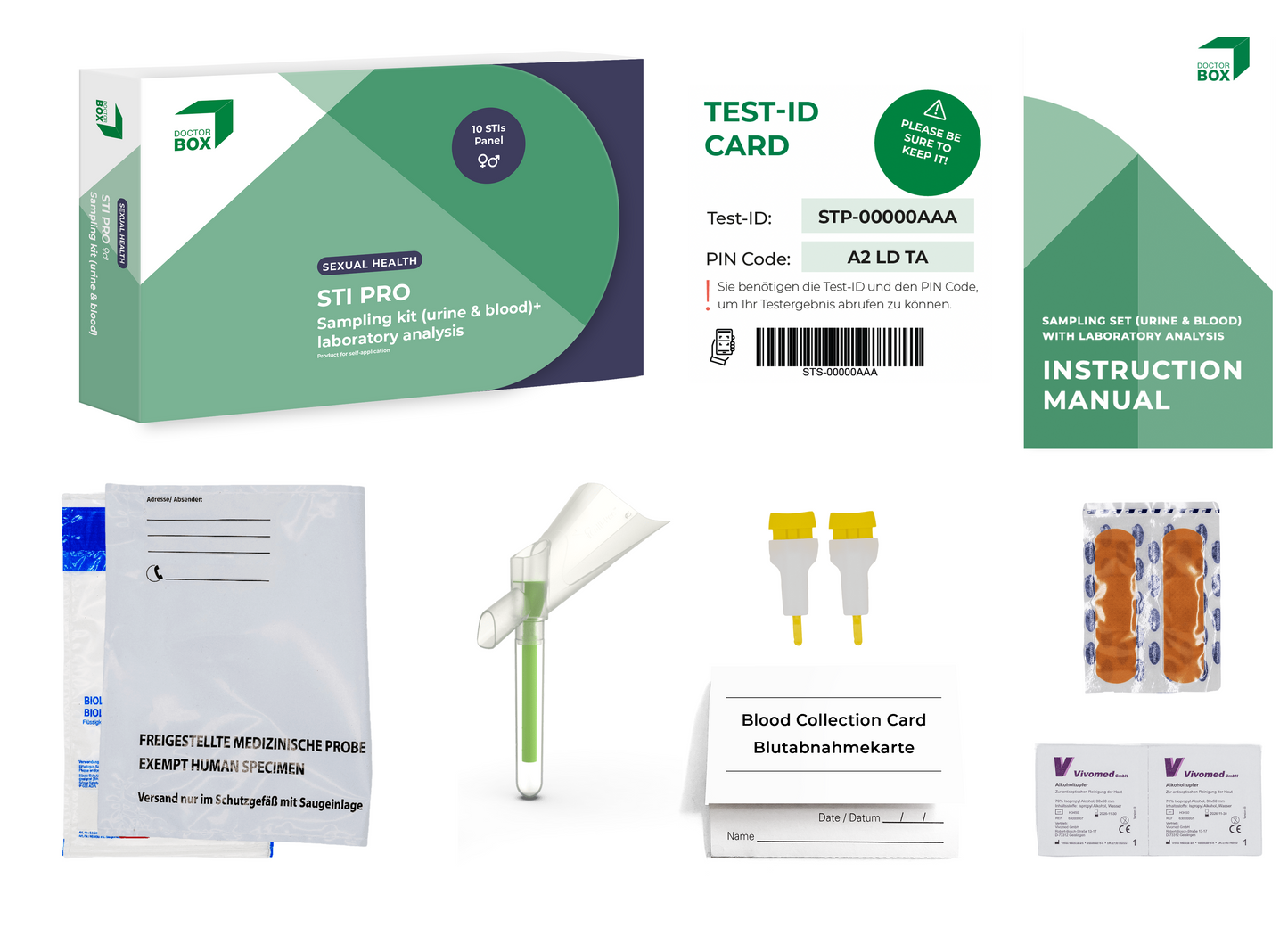

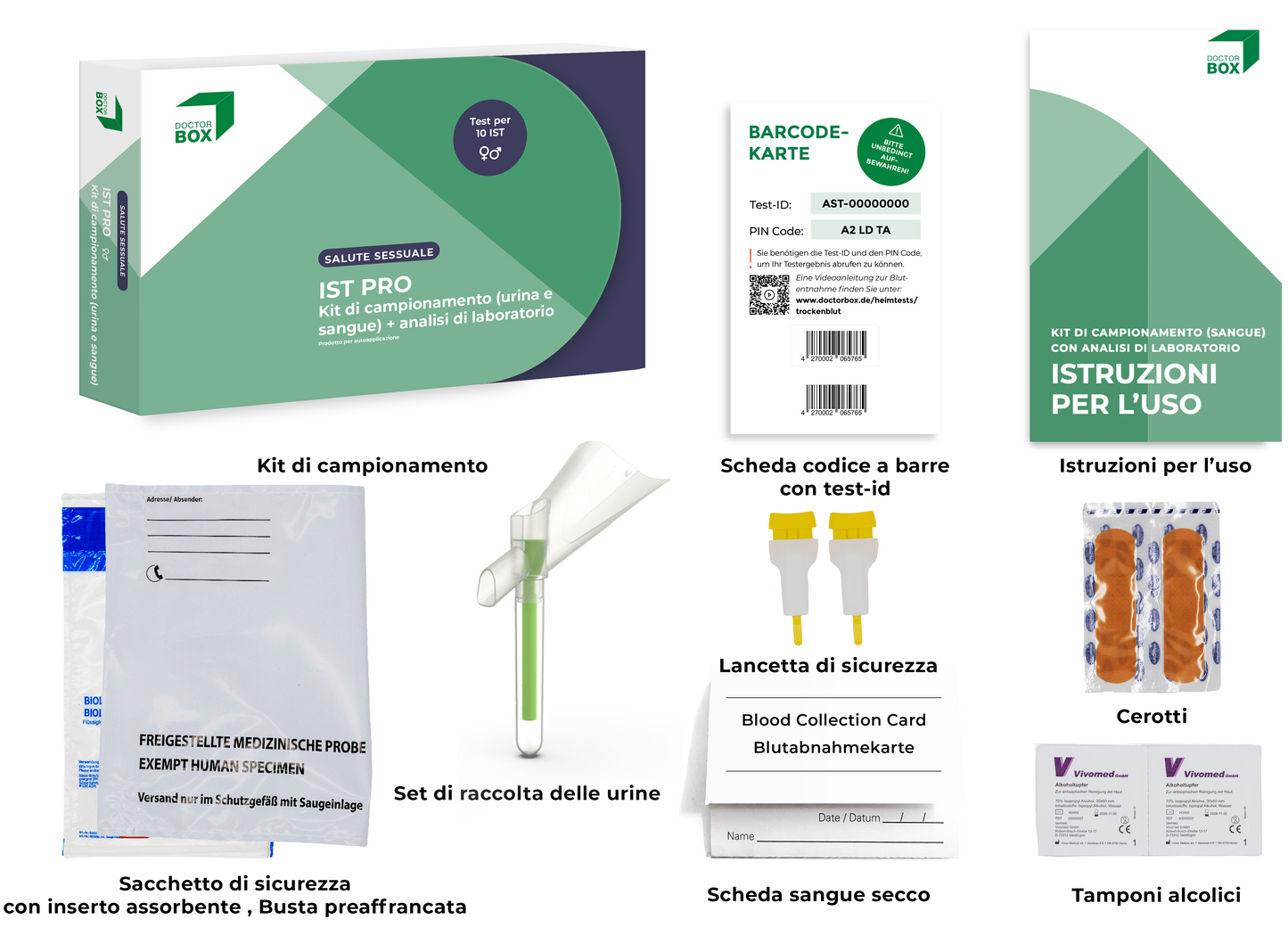
Take care of your sexual health from home easily and painlessly. With the STI Pro home test, you can test yourself in the comfort of your own home and prioritize your sexual health without having to travel, wait a long time, or make an unpleasant visit to the doctor.
Urine and blood tests for
✓ HIV (screening test*)
✓ Chlamydia
✓ Gonorrhea (gonorrhea)
✓ Trichomonas
✓ Mycoplasma genitalium
✓ Mycoplasma hominis
✓ Ureaplasma parvum
✓ Ureaplasma urealyticum
✓ Hepatitis C (screening test*)
✓ Syphilis (Lues) (screening test*)
Digital health is very important to us! With our DoctorBox App, you can:
Digital health is very important to us! With our DoctorBox app, you can:
- Keep track of the testing process digitally
- If necessary, schedule a doctor's visit online through the app
- Order your medications through our health marketplace if needed
*For these infections, only a screening or detection test is performed, without confirmatory diagnosis. If you receive a "reactive" result, consult a licensed physician immediately to confirm or rule out the result.
Sexually transmitted infections (STIs) can affect both men and women and can cause a wide range of symptoms and effects. It is important to note that not everyone who has an STI will necessarily develop symptoms. In addition, symptoms can vary in severity among those affected. The symptoms listed below can also be attributed to other health problems. For this reason, testing for STIs at regular intervals is recommended.
1. Chlamydia (Chlamydia trachomatis) - symptoms and effects:
Chlamydia (Chlamydia trachomatis) is a group of bacteria that can cause various infections in the urinary and genital tract. In particular, DK types are specifically responsible for chlamydia infections in this area. These infections manifest, for example, as cervicitis or urethritis with symptoms such as burning during urination or discharge. In men: typical symptoms in men are pain during urination and abnormal discharge from the penis. If the infection is left untreated, bacteria can rise up and cause inflammation of the prostate or internal female reproductive organs, which can lead to infertility. It can also lead to so-called pool conjunctivitis, an inflammation of the conjunctiva that can be transmitted through contact with water. In women: the infection often progresses without clear symptoms in women, which is why they may be carriers without realizing it. This infection poses a particular risk during pregnancy, as the unborn child may be harmed. Another form of chlamydia, namely the L1-L3 types, leads to the sexually transmitted disease 'inguinal lymphogranuloma.' This disease is characterized by enlarged lymph nodes in the groin area and occurs mainly in tropical and subtropical regions.
2. Gonorrhoea (Neisseria gonorrhoeae) - symptoms and effects:
The sexually transmitted disease gonorrhea, caused by the bacterium Neisseria gonorrhoeae, manifests with various symptoms and effects that vary according to sex. In men: during the acute phase, about 2-7 days after infection, men may experience symptoms such as urethritis. This is characterized by itching, purulent discharge, painful urination and frequent need to urinate. However, some men may not notice any symptoms for up to a month. If the infection is not treated, there is a risk of prostate inflammation in the chronic phase. In women: in women, infection may occur even without symptoms, which means the disease remains undetected for a long time. Alternatively, local inflammatory reactions affecting the bladder or female reproductive organs such as the ovaries may occur. In the worst cases, such inflammation can lead to infertility.
3. trichomonas (Trichomonas vaginalis) - symptoms and effects:
Trichomonas are microorganisms that cause a sexually transmitted disease. Surprisingly, most people infected with Trichomonas vaginalis remain asymptomatic and the infection can go undetected for years. In women and men: trichomoniasis affects both women and men, although symptoms are more common in women. Symptoms can occur within 5 to 28 days of infection. Typical symptoms include pain, burning, or itching in the vagina (vaginitis), urethra (urethritis), or penis. There may also be thin, foul-smelling vaginal discharge. Symptoms in both sexes may become more pronounced during sexual intercourse and during urination.
4. Mycoplasma genitalium - symptoms and effects:
The infection causes inflammation of the urethra (urethritis) in both men and women, which is accompanied by mucopurulent discharge from the urinary tract and painful urination. In women: In women, the infection can also cause inflammation of the cervix (cervicitis) and internal genitalia. These inflammations can lead to long-term infertility.
5. Mycoplasma hominis - symptoms and effects:
Mycoplasma hominis infection primarily causes inflammation of the ureter (urethritis). It has also been associated with potential effects on male fertility. In women, it can cause inflammation of the vagina (vaginosis) or cervix (cervicitis).
6. Ureaplasma parvum - symptoms and effects:
In rare cases, invasive infections of the urinary and genital area can be caused by Ureaplasma parvum. These are characterized by inflammation of the ureter (urethritis). However, Ureaplasma parvum has also been found in many healthy men.
7. Ureaplasma urealyticum-symptoms and effects:
An infection with Ureaplasma urealyticum can cause several pathologies in the urinary and genital area. These symptoms vary according to gender: In women: In women, the infection can cause inflammation of the urinary tract (urethritis), bacterial vaginosis, and inflammation of the cervix (cervicitis). In men: In men, however, inflammation of the urinary tract (urethritis) or inflammation of the prostate (prostatitis) may occur. A characteristic symptom associated with this infection is the so-called "fishy" odor, which occurs in both women and men. This odor is caused by the bacterium's ability to break down urea. Early detection and appropriate treatment of Ureaplasma urealyticum infections play an essential role in minimizing potential complications and protecting health.
8. HIV (Human Immunodeficiency Virus)
Acute infection often goes unrecognized because it is associated with no symptoms or nonspecific flu-like symptoms in both men and women. If untreated, it is followed by a silent phase of the disease that lasts for years. This later develops into the symptomatic phase of AIDS, which manifests as a severe impairment of the immune system in both men and women. The resulting infections can affect various organs.
9. Hepatitis C
During initial infection, both men and women often have mild or no symptoms for 4-12 weeks after infection. Occasionally, flu-like symptoms, dark urine, abdominal pain, and yellow-colored skin may occur. The virus remains in the liver of most people infected for the first time and later leads to chronic infection, which usually progresses without obvious symptoms. Over many years, however, it can lead to liver disease and, as a complication, cirrhosis, in which the liver gradually loses its function.
10. syphilis (lues)
About 2-3 weeks after syphilis infection, both men and women may experience swelling of the lymph nodes in the genital area. This is often accompanied by painless mucosal lesions on the genital organs, which normally heal on their own. During vaginal intercourse, these lesions may occur on the penis as well as on the labia or in the vagina. During oral sex, mucosal lesions are possible in the mouth or throat, while the rectum may be affected during anal sex. In the later stages of infection, a rash may appear on the hands and feet. If the infection is not treated, it can persist in the body for years and damage all organs. Such infection poses a particular risk during pregnancy, as the unborn child may suffer serious damage.
After your sample has been analyzed in the specialized medical laboratory, you will receive your individual results in digital format via the DoctorBox app. The results are clearly presented and the additional information is worded in a way that even "laymen" can understand. Additional information about each MST is available. You will also receive a report in PDF format, which you can also download.
Results will be available in English.
Install the free DoctorBox app on your smartphone using the links below to the App Store or Play Store. Once you have completed the registration process, go to "Home test" in the menu and then to "Test result."
Select the correct test and scan the barcode on your Test-ID Card. The test is now registered in the DoctorBox app, so you will receive information within the app when the result is available.
The STI Pro test is recommended for people at high risk and who change partners frequently. It tests for ten common sexually transmitted infections: HIV, Chlamydia, Gonorrhea (gonorrhea), Trichomonas, Mycoplasma genitalium, Mycoplasma hominis, Ureaplasma parvum, Ureaplasma urealyticum, Hepatitis C, and Syphilis.
This comprehensive test provides a thorough examination that ensures early detection and treatment of potential infections to protect health and prevent spread.
Results should arrive within about 3 working days after sending the sample. Please pay attention to notifications in the DoctorBox app. Results are often evaluated more quickly.
Please note that this is an estimate and may vary, especially during vacation periods or other unexpected delays. If you believe your sample will be significantly delayed, please contact our customer service department.
DoctorBox home tests should not be used:
- If you are under the age of majority (18 years or older)
- If you have trouble looking at or drawing blood, perform the test in the presence of another adult or have it performed by a health care professional.
You should use DoctorBox home tests only after consulting with your doctor if:
you suffer from a bleeding tendency or coagulation disorder or are taking anticoagulant medications.
Other than that, home tests are completely safe, as long as all materials are used only for their intended purpose.
Yes, you can also send the sample over the weekend. The IST Pro test is designed so that the sample can be packed and shipped safely, regardless of the day of the week.
Samples are stable for up to 7 days. If possible, avoid putting samples in the mailbox on particularly hot days. Ideally, choose another day for collection or take the sample to a post office. However, results are sent only during the week.
.Our urine collection kit contains a preservative that ensures sample stability. These special kits are designed to keep urine samples stable for longer periods of time so that the sample analysis can be performed reliably in the laboratory.
However, it is recommended to send the sample as soon as possible to ensure the best quality and accuracy of the test results. In summer, make sure that the sample is not exposed to the sun for too long.
Please pay attention to the emptying times of mailboxes or bring the sample ready for mailing to a post office. During the cold season, there are no problems in sending the sample; the cold weather aids the preservation process. For more detailed information on sample stability time, please contact DoctorBox customer service.
How it works

Carry out sampling
Before you start sampling, please read the enclosed instructions for use carefully.
Scan barcode
Bar code final scanning
Send samples
Pack your sample as described in the instructions. Take the prepaid envelope to the post office on the same day.
Your findings
After the laboratory analysis, your test result is transferred to your DoctorBox app, your health account. You can view the current status there at any time.


